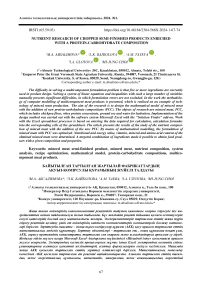Nutrient research of chopped semi-finished products enriched with a protein-carbohydrate composition
Автор: Absalimova M.A., Baibolova L.K., Tayeva A.M., Glotova I.A., Choi Mi.ju.
Журнал: Вестник Алматинского технологического университета @vestnik-atu
Рубрика: Технология пищевой и перерабатывающей промышленности
Статья в выпуске: 1 (143), 2024 года.
Бесплатный доступ
The difficulty in solving a multicomponent formulation problem is that five or more ingredients are currently used in product design. Solving a system of linear equations and inequalities with such a large number of variables manually presents significant difficulties, in which formulation errors are not excluded. In the work the methodology of computer modelling of multicomponent meat products is presented, which is realized on an example of technology of minced meat production. The aim of the research is to design the mathematical model of minced meat with the addition of new protein-carbohydrate compositions (PCC). The objects of research are minced meat, PCC, which includes chickpea flour, whey protein concentrate, ground soy and water for hydration. Implementation of the design method was carried out with the software system Microsoft Excel with the "Solution Finder" add-on. Work with the Excel spreadsheet processor is based on entering the data required for calculation, calculation formulas into the corresponding cells of the spreadsheet. The article presents the results of the study of the nutrient composition of minced meat with the addition of the new PCC. By means of mathematical modelling, the formulation of minced meat with PCC was optimized. Nutritional and energy value, vitamin, mineral and amino acid content of the obtained minced meat were determined. A targeted combination of ingredients made it possible to obtain food products with a given composition and properties.
Minced meat semi-finished product, minced meat, nutrient composition, system analysis, recipe optimization, mathematical model, protein-carbohydrate compositions, multico- mponent meat products
Короткий адрес: https://sciup.org/140304546
IDR: 140304546 | DOI: 10.48184/2304-568X-2024-1-67-74
Текст научной статьи Nutrient research of chopped semi-finished products enriched with a protein-carbohydrate composition
IRSTI (65.59.03)
According to nutrition scientists, the solution to the issue of food balance can be achieved due to their multicomponence. The design of multicomponent products is dictated by the possibility of regulating the chemical composition of products in accordance with modern requirements of the nutrition science. The main requirement is that the simulated multicomponent food products should be characterized as close as possible to the reference (scientifically based physiological norms) nutrient composition [1- 3].
The development of criteria for assessing the balance of food products has led to the development of a whole set of mathematical dependencies reflecting individual qualitative assessments of the multicomponent food balance [4].
The theory of a balanced diet states that food, i.e. the human diet itself, should contain a certain amount of nutrients corresponding to the daily norm for a given age group [5]. A food product is considered unbalanced if the amount of nutrients exceeds or falls short of the acceptable norm. Accordingly, this dependence of the human body on the amount of nutrients helps to assess the nutritional and biological value of the food being modeled [6].
The development of new technologies for meat semi-finished products will expand the range and increase the production of these products. Researchers in this field face the task of industrial production of semi-finished meat products and supplying them to public catering enterprises. The widespread use of meat semi-finished products of increased nutritional and biological value in pub- lic catering enterprises will ensure the physiological nutrition standards of individual population groups. The use of meat semi-finished products of industrial production will also ensure high levels of sanitation, hygiene and food safety.
Various types of animal meat such as beef, horse meat, lamb, and pork are used for the preparation of semi-finished products [7,8].
Currently, various fillers are used to enrich meat semi-finished products. One of the most popular and effective fillers now are protein-carbohydrate compositions.
When incorporating fillers into the recipe composition of minced meat semi-finished products, it's essential to opt for those with minimal added ingredients. The inclusion of numerous ingredients diminishes the shelf life and marketability of semi-finished products, rendering them less appealing to consumers. Hence, minced meat was selected as the subject of this study.
Vegetable-origin proteins and carbohydrates can be used as ingredients to produce pro-tein-carbohydrate compositions. Additionally, combinations of vegetable proteins and carbohydrates with those of animal origin can be utilized to create compositions with mixed ingredients [9].
Food products containing vegetable raw materials in the composition are rapidly gaining momentum among consumers, companies, and investors. At the same time, leguminous crops have become widespread, which encourages food companies to create meat analog products that include legumes as the main substitute for meat protein. Although many factors determine the popularity of plant-based foods, one of the main factors is their environmentally sustainable production. Many consumers are unaware of the environmental sustainability of legume-based meat alternatives compared to meat-based analogues. Economically safe sustainability in the entire food chain can be explained by the fact that the transition from meat products to legumes dramatically reduces the need for land and water use, as well as carbon sediment that occurs in the food production process. Replacing meat raw materials with at least one vegetable component begins to have an impact on the environment. As this impact increases, products based on legume meat analogues can play an important role in reducing carbon emissions and slowing global warming and can also help preserve the health of the planet for future generations [10].
Thus, the main purpose of the study is to design a mathematical model of minced meat with the addition of a new protein-carbohydrate composition of a combined composition, to enrich and reduce the cost of minced meat semi-finished product.
To achieve this goal, the following tasks were set:
-
- with the help of digital technologies to carry out a systematic analysis of the balance of the nutrient composition of the chopped semi-finished product, namely, to optimize the recipe of minced meat with beech, to investigate its chemical, vitamin, mineral, and amino acid composition.
Materials and research methods
The multicomponent minced meat was chosen as the object of research.
As a control sample, we took chilled minced meat in accordance with the state system of technical regulation of the Republic of Kazakhstan GOST 52675-2009, category B, during the production of which the recipe provides for a mass percentage of protein of at least 12.5%, a mass percentage of fat of no more than 27.0%.
During the research work, part of the meat raw materials was replaced with a new protein-carbohydrate composition, which includes chickpea flour, whey protein concentrate, ground soy and water for hydration.
The mass fraction of moisture was determined according to state standard GOST 9793; total protein – by the Kjeldahl method (GOST 25011); fat - refractometrically (according to GOST 23042). The amino acid composition was determined by capillary electrophoresis. The mineral composition was determined by atomic absorption method. The vitamin composition was determined using high-performance liquid chromatography (HPLC).
The recipe of the new minced meat was optimized by the simplex method. The system-analytical method of research was applied. To assess the level of balance of multicomponent foods, it is proposed to use six dimensionless partial indices:
-
1. PCBI –Prescription composition Balance Index (Ip);
-
2. VCBI – Vitamin composition Balance Index (Iv);
-
3. MCBI – Mineral Composition Balance Index (Im);
-
4. AACBI – Amino Acid Composition Balance Index (Ia);
-
5. EVBI – Energy Value Balance Index (Ie).
These indices make it possible to comprehensively assess the level of balance at each stage of food design.
The ideal balance of the product will be achieved when the partial balance indices are equal to one, i.e. Ip = 1, Iv =1, Im = 1, Ia = 1, Ie =1.
Literature review
Enriched products are products that look like traditional food, but in which certain ingredients have been added or replaced by using various techniques that have a positive effect on the body as a whole or on its individual functions. The main component of enriched products, according to the definition, is functional ingredients due to which the product shows useful, health-promoting benefits [11].
For fortified meat products the most suitable ingredients are: minerals, dietary fiber, vitamins, and polyunsaturated fatty acids [12].
For the supplementing of the nutrient deficiency the most promising direction in the production of enriched food products is the use of vegetable raw materials and products of their processing. Herbal supplements are rich in a wide range of biologically active substances such as minerals, vitamins, amino acids, dietary fiber, polyunsaturated fatty acids, and also contain various phytocomponents [13].
The researchers also suggest using unconventional vegetable raw materials in the production of semichopped products such as pumpkin, zucchini, sunchokes, raisins, sea kale, spent grains, milk thistle meal, rhubarb, soy milk, soy cheese (tofu) and pro-tein-carbohydrate product (okara) etc. [14].
This is of great concern, considering that in 2015, the International Agency for Research on Cancer (IARC) classified processed meats as a Group-1 carcinogen for human colorectal cancer, and red meat was classified as probably carcinogenic to humans (Group 2A) based on a comprehensive review of epidemiologic evidence, combined with “strong mechanistic evidence supporting a carcinogenic effect” [15]. Based on this, the IARC has recommended reducing the consumption of red and processed meats for cancer prevention.
Therefore, considering the abovementioned issues, in this short review, we aim to evaluate the use of meat extenders as substitutes of animal proteins and assess their impact on the technological properties of meat products, considering the most recently available findings on the topic. Overall, we first described the up-to-date sustainability-related issues related to meat products, then assessing the potential of different more conventional and emerging extenders potentially available for meat industry.
Results and discussion.
At the first stage of design, an information database of the ingredient composition for the production of a control sample of minced meat is formed in the Excel spreadsheet processor (Fig. 1). Also, Figure 1 shows summary data of the recipe composition of minced meat (control sample), with calculated values of the cost of 100 kg of product, partial indices of the balance of the recipe composition and energy value.
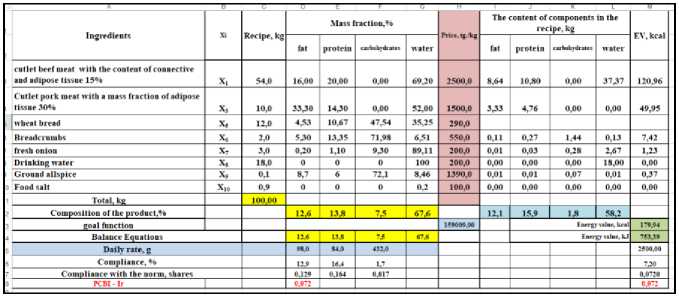
Figure 1 – Summary data of the recipe composition of minced meat (control sample), with calculated values of the 100 kg product cost, recipe composition and energy value balance indexes
Studies have shown (Fig. 1) that the cost of 100 kilograms of minced meat, which includes beef, lamb, chicken and beef fat, is 159009,00 tenge.
Figure 2 shows a summary data of the recipe for multicomponent minced meat with a pro-tein-carbohydrate vegetable composition.
As a result, we received a recipe for minced meat, the cost of which was 138569,00 tenge per
100 kg, which is significantly lower than the cost of the control sample (159009,00 tenge per 100 kg), where, in turn, the level of balance of the compounding composition of composite minced meat increased significantly due to changes in its private indexes.
|
Ингредиенты |
Xi |
Recipe, kg |
Mass fraction,% |
Цена. ir.кг |
The content of components in the recipe, kg |
EV, ксаі |
||||||
|
fat |
protein |
carbohydrates |
water |
fat |
protein |
carbohydrates |
water |
|||||
|
Cutlet beef meat with the content of connective and adipose tissue 15% |
X, |
41,0 |
16,00 |
20,00 |
0,00 |
69,20 |
2500,0 |
6 56 |
8,20 |
0,00 |
2837 |
91,84 |
|
Minced chicken |
Xt |
10,0 |
18,00 |
18,00 |
0,00 |
63,00 |
1250,0 |
1,80 |
1,80 |
0,00 |
6,30 |
23,40 |
|
Wheat bread |
x= |
0,0 |
4,53 |
10,67 |
47,54 |
35,25 |
290,0 |
|||||
|
Breadcrumbs |
x6 |
2-0 |
5,30 |
13,35 |
'1,98 |
6,51 |
550,0 |
0,11 |
0,27 |
1,44 |
0,13 |
7,42 |
|
Fresh onion |
X7 |
3,0 |
0.20 |
1,10 |
9.30 |
89,11 |
200,0 |
0,01 |
0,03 |
0.28 |
2,67 |
1,23 |
|
Drinking water |
Xs |
18,0 |
0 |
0 |
0 |
100 |
200,0 |
0,00 |
0,00 |
0,00 |
18,00 |
0,00 |
|
Ground allspice |
X9 |
0,1 |
8,7 |
6 |
72,1 |
8,46 |
1390,0 |
0,01 |
0,01 |
0,07 |
0,01 |
037 |
|
Food salt |
Хю |
0-9 |
0 |
0 |
0 |
0-2 |
100,0 |
0,00 |
0,00 |
0,00 |
0,00 |
0,00 |
|
PCC including: chickpea flour |
X11 |
6,0 |
4,10 |
28,40 |
12,10 |
53.20 |
500,0 |
0,25 |
1,70 |
0,73 |
3,19 |
11,75 |
|
okara soy mince |
Xu |
4,00 |
4 5 |
7,6 |
1,7 |
82 |
845,0 |
0,18 |
030 |
0,068 |
3,28 |
3,09 |
|
whey protein concentrate |
Х13 |
5,00 |
63 |
80,0 |
4 |
5 |
1932,0 |
0.32 |
4,00 |
0.200 |
0350 |
19,59 |
|
water |
Xu |
10.00 |
0 |
0 |
0 |
100 |
200,0 |
0,00 |
0,00 |
0 |
10,000 |
0 |
|
Total, kg |
100,00 |
|||||||||||
|
Composition of the product,% |
16.3 |
2,8 |
72,2 |
9.2 |
163 |
2,8 |
722 |
|||||
|
goal function |
138569,00 |
Energy value, kcal |
158,69 |
|||||||||
|
Balance Equations |
9-2 |
16,3 |
2,8 |
72,2 |
Energy value, kJ |
664,45 |
||||||
|
Daily rate, g |
98.0 |
84.0 |
432,0 |
2500.00 |
||||||||
|
Compliance, % |
9-4 |
19,4 |
0,6 |
635 |
||||||||
|
Compliance with the norm, shares |
0.094 |
0,194 |
0,006 |
0,0635 |
||||||||
|
PCBI - Ir |
0,049 |
0,063 |
||||||||||
Figure 2 - Summary data of the recipe composition of minced meat with PCC, with calculated values of the 100 kg product cost, recipe composition and energy value balance indexes
Figure 2 shows that the energy partial balance index of minced meat with PCC 0.063, which is a caloric value equal to 158,69 kcal, compared with the control sample of 179, 94.
The vitamin composition partial balance index of minced meat with PCC, VCBI = 1,524, Table 1 - Vitamin composition of minced meat.
increased by 0.25 compared to the control sample (1,277). Table 1 presents the research results of the vitamin composition in multicomponent minced meat.
|
Name of minced meat |
Vitamins, mg/per 100 g of product |
||||||
|
А |
Е |
Вб |
Ві |
РР |
Bs |
В2 |
|
|
Control sample |
0,12 |
0,91 |
29,85 |
15,74 |
29,31 |
9,70 |
13,60 |
|
Test sample |
0,33 |
1,51 |
25,87 |
10,83 |
21,81 |
13,29 |
17,09 |
According to the results of the study, it can be seen that the product contains vitamins necessary for the normal functioning of the human body, among which vitamin A can be distinguished, the content of which has doubled (0,33%), compared with the control sample
(0,12%). The content of vitamins Bs and B2 increased by 3,5% as well.
The mineral composition partial balance index is equal ISMS = 0,098, when in the control sample it is equal to 0,090. Figures 3 and 4 show the mineral score of the control and test samples.
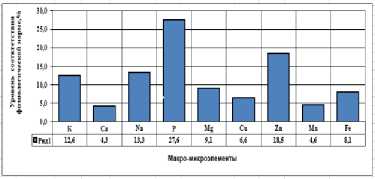
Figure 3 - Mineral composition of minced meat with PCC
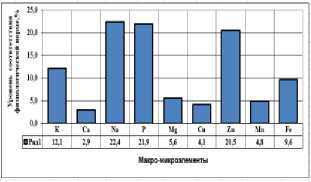
Figure 4 - Mineral composition of the control sample
From the data of the above diagrams, the mineral composition of the resulting minced meat with PCC was determined. Among the macronutrients, magnesium can be observed, the content of which increased by 3,5 % (9,1 mg), compared with the control sample (5.6 mg). The content of potassium (12,6%) and calcium (4,3%) has significantly increased. Among the microelements, cuprum can be distinguished, the content of which increased by 2,5% (6,6 mg), compared with the control sample (4,1 mg).
The amino acid score of multicomponent minced meat with PCC is calculated. The partial balance index of the amino acid composition is equal to AACBI = 1,145, which is lower than the value of the control sample (1,18). Figures 5 and 6 show graphic illustrations of the amino acid score of minced meat.
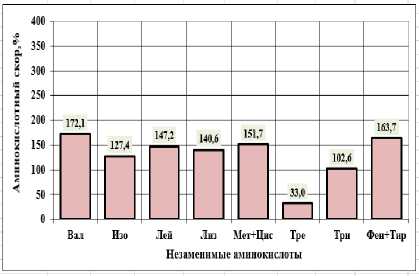
Figure 5 – The amino acid score of the control sample when calculating the formulation at the minimum cost of the product.
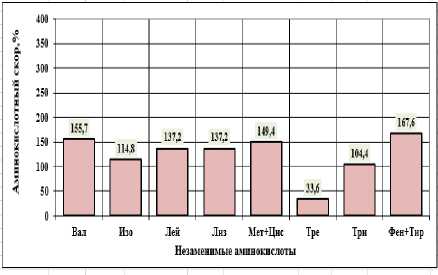
Figure 6 – Amino acid score of minced meat with PCC when calculating the recipe at the minimum cost of the product.
According to the results of the amino acid score research in minced meat with PCC, it can be concluded that the percentage of limiting acid threonine increases and is equal to 33,6, in comparison with threonine (33,0) of the control sample.
A comparative assessment of the compounding composition balance level of the composite minced meat with the control sample is given in Table 2.
Table 2 – Сomparative assessment of the compounding composition balance level of multicomponent minced meat.
|
Ingredients |
Index, Х I |
Formulations, kg (excluding losses) and values of indicators |
|
|
A control sample of minced meat at the minimum cost of the product |
Minced meat with PCC at the minimum cost of the product. |
||
|
Cutlet beef meat |
Х 1 |
54,0 |
41 |
|
Cutlet pork meat |
Х 2 |
10 |
- |
|
Minced chicken |
Х з |
- |
10 |
|
Wheat bread |
Х 4 |
12 |
- |
|
Breadcrumbs |
Х 5 |
2 |
2 |
|
Fresh onion |
Х б |
3 |
3 |
|
Drinking water |
Х 7 |
18 |
18 |
|
Ground allspice |
Х 8 |
0,1 |
0,1 |
|
Food salt |
X 9 |
0,9 |
0,9 |
|
PCC inc: chickpea flour |
Хю |
- |
6 |
|
Okara soy mince |
Хи |
- |
4 |
|
Whey protein concentrate |
Хи |
- |
5 |
|
Water for hydration |
Х13 |
- |
10 |
|
Mass fraction, % |
|||
|
Fat |
12,6 |
9,2 |
|
|
Protein |
13,8 |
16,3 |
|
|
Carbohydrate |
2,8 |
2,8 |
|
|
Water |
72,2 |
72,2 |
|
|
PCBI - Ir |
0,072 |
0,049 |
|
|
Energy value, kJ |
753,39 |
664,45 |
|
|
EVBI |
0,072 |
0,063 |
|
|
The cost per 100 kg, tg. |
159009,00 |
138569,00 |
|
|
VCBI - Iv |
1,277 |
1,524 |
|
|
MCBI - Im |
0,090 |
0,098 |
|
|
AACBI - Ia |
1,18 |
1,14 |
|
|
the Harrington criteria |
0,234 |
0,330 |
|
Conclusion.
The use of modern digital technologies makes it possible to solve complex technological problems in the design of multicomponent meat products efficiently and while at the same time accurately managing the design process.
The use of the Harrington criteria made it possible to make an integral assessment of the balance of the projected minced meat with PCC and to carry out a comparative assessment of the nutritional and energy value with the control sample.
According to the results of the research, it is clear that the recipe for minced meat with PCC is optimal, since the percentage of fat (9,2% - no more than 27.0%) and protein (16,3% - no less than 12.5) in the product is not lower than the indicators given in the state system of technical regulation of the Republic of Kazakhstan GOST 52675-2009.
The conducted studies indicate an increase in the balance level of the formulation composition of the resulting multicomponent minced meat with the new PCC. Specifically, the Vitamin Composition Balance Index increased from 1.277 to 1.524, the Mineral Composition Balance Index increased from 0.090 to 0.098, and the Amino Acid Composition Balance Index decreased from 1.18 to 1.14. Сomparable redundancy indicator in the resulting minced meat with PCC is equal to 61.30, which shows a significant decrease compared to the control sample, where CRI = 66,72. This has a positive effect on the quality of minced meat with PCC, since the ideal value of the CRI is close to the reference value σ = 0. The generalized Harrington criteria shows a significant increase from 0.234 to 0.330, while reducing the cost of multicomponent minced meat with PCC by 12%.
Computer information systems can be used to conduct an economic analysis of production processes, perform a comparative assessment of the balance of products developed and used at the enterprise, and suggest ways to reduce production costs without compromising quality and increase profits. It is important to note that no capital expenditures are required for production in this case.
Thus, the resulting multicomponent minced meat is a product with high nutritional and biological value, at a reduced cost, due to the replacement of part of the meat raw materials with filler.
Список литературы Nutrient research of chopped semi-finished products enriched with a protein-carbohydrate composition
- Lisin, P.A. Komp'yuternoe modelirovanie tekhnologicheskih processov pishchevoj promyshlennosti. [Somputer modeling of technological processes in the food industry] - SPb.: Publishing house «LAN», 2016. - 254 RR. (In Russian)
- Lisin, P.A. Modelirovanie recepturnoj smesi mnogokomponentnyh myasnyh produktov s primeneniem simpleks-metoda [Modeling a recipe mixture of multicomponent meat products using the simplex method]// Vestnik. OmGAU. - 2014. - №1 - P. 73-76.
- O.N. Krasulya, S.V. Nikolaeva, A.V. Tokarev. Modelirovanie receptur pishchevyh produktov i tekhnologij ih proizvodstva. [Modeling of recipes for food products and technologies for their production]. - SPb.: GIORD, 2015. - 320 p. (In Russian)
- Kallaur, E. G. Kak zhit', chtoby zhit' dolgo [How to live to live long] / E. G. Kallaur ; Ministerstvo obrazovaniya Respubliki Belarus', Uchrezhdenie obrazovaniya «Mozyrskij gosudarstvennyj pedagogicheskij universitet imeni I. P. SHamyakina». - Mozyr': MGPU im. I. P. SHamyakina, 2020. - 288 r. (In Russian)
- Musina, O.N. An approach to the choice of alternatives of the optimized formulations // Foods and Raw Materials. - 2015. - T.3. № 2. - PR. 65 - 73.
- Lipatov, N.N. Formalizovannyj analiz amino- i zhirnokislotnoj sbalansirovannosti syr'ya, perspektivnogo dlya proektirovaniya produktov detskogo pitaniya s zadavaemoj pishchevoj adekvatnost'yu [Formalized analysis of amino and fatty acid balance of raw materials, promising for the design of baby food products with specified food adequacy] // Hranenie i pererabotka sel'hozsyr'ya. - 2001. - №8. - PR.11 - 14. (In Russian)
- Skurihin I.M Tablicy himicheskogo sostava i kalorijnosti rossijskih produktov pitaniya: spravochnik [Tables of Chemical Composition and Caloric Content of Russian Foodstuffs: Reference Book]. Skurihin I.M., Tutel'yam V.A. - M.: DeLi print, 2008. - p. 356 (In Russian)
- GOST 33102-2014 Produkciya myasnoj promyshlennosti. Klassifikaciya [Meat industry products. Classification]. - p. 6. (In Russian)
- David Julian McClements & Lutz Grossmann, A brief review of the science behind the design of healthy and sustainable plant-based foods, // Science of Food. - 2021. - №17.- PP. 1 - 10.
- Kowalski, Ryan J. Sustainability Impacts of Pulses in Meat-Analogue Food Products, // Cereal Foods World. - 2019. - №4. - RP. 32-34.
- Callaway, J.C., 2004. Hempseed as a nutritional resource: an overview. In: Euphytica, vol. 140(1-2). - PP.65-72.
- Shalimova, O.A., 2008. Meat semi-finished products using non-traditional functional fillers. In: Meat Technologies, vol. 3. -RR. 36-38.
- Leizer, C., Ribnicky, D., Poulev, A. et al., 2000. The Composition of Hemp Seed Oil and Its Potential as an Important Source of Nutrition. In: Journal of Nutraceuticals Functionaland Medical Foods, vol. 4(2).- RR. 35-53
- Shalimova, O.A., 2008. Meat semi-finished products using non-traditional functional fillers. In: Meat Technologies, vol. 3, pp. 36-38.
- Manoela A. P., Julliane C. B., Isabela R., Paulo E. S., Marco A. T. Improving the lipid profile of bologna type sausages with Echium (Echium plantagineum L.) oil and chia (Salvia hispanica L) flour. In: LWT, vol. 119. - RR. 67-68.

